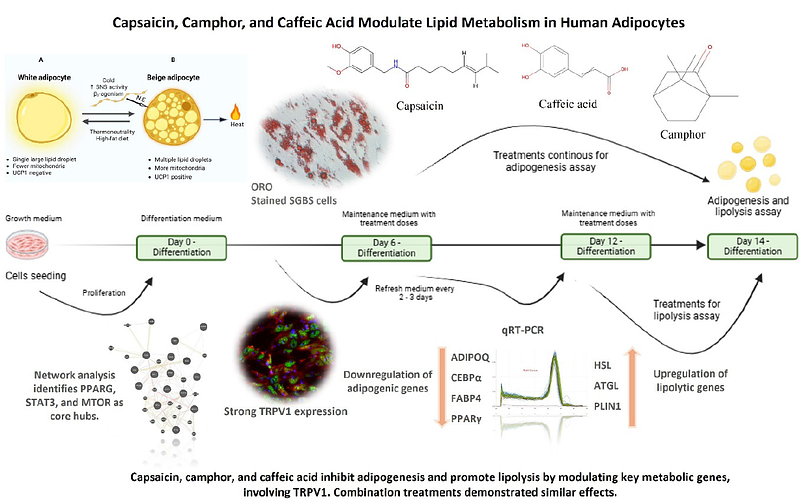Lipolytic and Anti-Adipogenic Effect of Capsaicin, Camphor, and Caffeic acid on Human SGBS Adipocytes

Lipolytic and Anti-Adipogenic Effect of Capsaicin, Camphor, and Caffeic acid on Human SGBS Adipocytes
Ali, U.; Wabitsch, M.; Gregurec, D.
AbstractExcess fat accumulation contributes to metabolic disorders such as insulin resistance, type 2 diabetes, cardiovascular disease and increases risk of dementia. Promoting lipolysis and inhibiting adipogenesis through natural compounds offers a promising therapeutic approach to obesity. This study investigates the lipolytic and anti-adipogenic effects of capsaicin, camphor, and caffeic acid in human Simpson-Golabi-Behmel Syndrome (SGBS) adipocyte model. First, we determined appropriate treatment concentrations using MTT assays, which demonstrated a dose dependent reduction in cell viability for all three compounds. Selected doses were applied to differentiating SGBS cells until day 14. Lipid droplet accumulation and free fatty acid release were assessed using Oil Red O (ORO) staining and a lipolysis assay kit, respectively. Gene expression of adipogenic and lipolytic markers was analysed by RT-PCR and TRPV1 receptor involvement was examined by immunofluorescence. A network pharmacology approach incorporating GeneCards, STITCH, and other databases revealed downregulation of PPARG, CEBPA, and FABP4, and upregulation of HSL, ATGL, and PLIN1. TRPV1 activation was prominent in capsaicin treated cells. Network analysis identified shared regulatory hubs such as PPARG, STAT3, and MTOR. All treatments significantly reduced lipid accumulation and increased lipolysis, with capsaicin showing the strongest effects. Combination treatments, especially capsaicin with caffeic acid, exhibited synergistic effects. While the previous studies showed interference of these compounds in the molecular pathways involved in fat cell metabolism, our work establishes for the first time potential thermogenic capacity of camphor individually and of combinatory effects of three compounds to inhibit adipogenesis and promote lipolysis in human adipocytes, potentially through TRPV1 signalling and modulation of metabolic gene networks. These findings highlight their therapeutic potential for metabolic disorders.